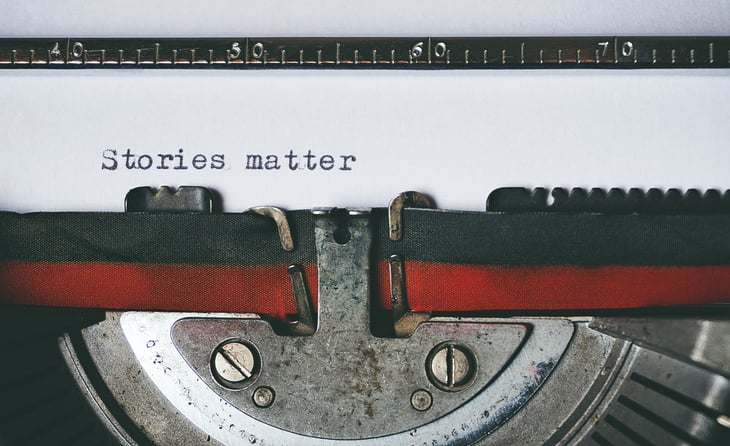Startup Branding 101: An Interview with Neil Wengerd of Nonfiction

From time to time, the startups we work with have questions about branding: do they need to develop clearer brand guidelines? Is it time for a rebrand? What does “brand” even mean for startups?
Brand isn’t our area of expertise, but it does matter to startups. So we sat down (virtually) With Neil Wengerd, partner and creative director at the brand and design agency Nonfiction.
Read on for our Q&A, in which Neil offers insights on why brand matters for startups, how to approach branding, and how startups can leverage brand to outshine their more established competitors.
Tell me about yourself.
 I’m a founding partner and creative director at Nonfiction. Around the office, I’m known for making obscure movie references, always having a stack of unread books nearby, and having every Seinfeld episode memorized.
I’m a founding partner and creative director at Nonfiction. Around the office, I’m known for making obscure movie references, always having a stack of unread books nearby, and having every Seinfeld episode memorized.
I live in Columbus with my wife, two kids, and one lazy Labrador.
What is the story behind Nonfiction?
Nonfiction is a brand and design agency for clients with optimism, soul, and a story to tell. Story is a common term in branding these days, but we still believe the best companies have real stories to tell. Real stories don’t need to be embellished, and they certainly don’t need to be fabricated. Hence, Nonfiction.
We ask “what if?” to shape what’s next. We challenge you to see things in a new light. We ask big questions, and then we work with you to find the right answers. We put meaning into everything that goes out into the world. We approach each relationship with empathy, patience, and passion to design brands that stand the test of time.
We aren’t content to sit by and let things happen to us or to our clients. What we do today determines the future. If we don’t shape the future, it will shape us.
Before we go too far, define "brand" within the context of this discussion – what is a brand and where does Nonfiction get involved?
Great question. I think many people get too tactical too quickly when it comes to the idea of “brand.” For a lot of people, a brand is a logo and color and font. Other people treat a brand more as a short-term advertising campaign.
That’s not what we’re talking about at Nonfiction when we say brand. To quote Marty Neumeier, a brand is a person’s gut feeling about a product or a service or a company. What we do as a brand agency is create the right tools, strategies, and design to positively influence that gut feeling.
"We create meaning, emotion, and identity to build brands that stand the test of time."
To put it another way, imagine two identical gray circles. Now imagine a larger circle around each, one blue and one red. Those colored frames show how the two gray circles are different. That’s what a great brand does: frames seemingly identical products or services to build the brand in the minds of customers.
When we get involved with a client, we work with them from first principles to invent or reinvent their brand. First, we take stock of where they’ve been and where they’re going. We do some research to understand their competitive and industry landscape. We talk to their employees and customers. Then, we plant some strategic flags around how they’re distinct and what they need to say to communicate that to the people who matter. From there, it’s a matter of translating this left-brained thinking into right-brained creative expression: naming, design, writing, tactical executions.
Boiled down, we create meaning, emotion, and identity to build brands that stand the test of time.
When you look at B2B startups that nailed their brand right out of the gate, what do you think they got right?
Everyone is obsessed with “minimum viable product.” But what we hear when we hear MVP is “crappy design and bad experience.” The B2B startups that get it right – think Slack, Zendesk, Stripe – are the ones that focus on design from the get-go.
It doesn’t have to be perfect. But don’t rush to get something out there that leaves a bad impression or causes confusion. A product and a brand are living, breathing things that should change over time. Mailchimp’s recent brand updates come to mind.
The other thing some of the great B2B startups did was to keep their mission simple. Salesforce = sales. Mailchimp = email communication. Slack = great team communication. Know what you’re trying to do, and avoid bloating your offer. That makes it much easier to be really good at what you do, which in turn builds distinctiveness.
When you look at early-stage B2B startups, what brand mistakes do you see most often?
Without a doubt, they get their messaging wrong. People are great at talking about what they do. They’re not so great at talking about why people should care. It’s a bit like going on a first date and spending the whole time talking about yourself. You’ve got to get to know the other person and find out what they’re interested in.
Spend time making sure you know what your customers get from you. Not just the product. But the benefits. That’s what they care about.
Does your product do things faster than the competitor? Great – talk about how it saves time for your customers. Does your product put all the information people need in one easily searchable place? Great – talk about how it makes your customers look, sound, and act smarter to their customers.
It comes down to the goals of your audience. Know their goals and speak to them.
How can a B2B startup know if they need to rethink their brand?
I’m glad you said “rethink” rather than rebrand. Rebranding is rare. Only when your entire company changes (new strategy, new name, new identity) is it really a rebrand.
More often, it’s a brand revitalization, reposition, or simply a refresh.
Do things feel stale? Are you not connecting with customers in the right ways, or at all? Are you unclear internally and externally on your messaging and visual identity? Have you changed in some critical ways? Then it’s probably time to revitalize your brand: a new brand strategy and brand identity while keeping the name the same.
Or maybe your design and writing are great. But you’re not connecting on some fundamental communications or positioning strategies. Then it’s time to reposition things strategically but keep elements of the creative side intact.
The opposite is true with a brand refresh. Your strategy is sound, but the creative side is flat. Take a fresh approach to the design and writing, building on the strategic foundation.
Can a B2B startup handle a rebrand internally, or do you need an outside expert?
At the risk of sounding self-serving, you need an outside expert.
First, you’re too busy running the business to take on the whole project yourself. Even if you have an internal team, they’re focused on the day-to-day brand management and don’t have the time to do it right.
Second, without an outside point of view, you’re bringing all kinds of assumptions and biases to the project. You need the objectivity that an expert brings.
And lastly, it’s right there in the name: outside expertise. It’s easy to fall into the trap of either thinking you know it all or thinking you should bootstrap it all. Don’t. Just like you go to a specialist for healthcare, sometimes it’s time to call in the pros.
If a B2B startup signs on with a branding shop, what can they expect in terms of process, options, pricing, etc?
I can only speak for Nonfiction, but the typical process lasts six to nine months plus any additional things like web development. First we build the foundation of the brand: research, strategy, naming, visual and verbal identity. Then we create the brand experience: all the digital and physical ways people interact with the brand.
Options are pretty fixed in terms of process, but we usually propose different ways of engaging with the client team. Do we take the whole thing on, removing it from their plates entirely? Do we work more closely with their internal team? And do we sign on for some recurring brand work? All these things depend on the size and skillset of the client team.
The market range for a full-on branding project is anywhere from $20k to $200k. Nonfiction typically falls somewhere in the high middle of that range. And we always charge a flat fee. Be wary of companies charging hourly. You want to minimize hours and they want to maximize hours. Great work is left out of that equation.
Once a rebrand is complete, how can a B2B startup know it's been successful?
Metrics differ depending on the client, but there are some typical hard and soft KPIs:
- Did web traffic increase?
- Did your MRR or ARR increase?
- Are you getting more leads and more actual customers?
All these are a product of a better brand, but also more informed brand communications tools. In particular, better recurring revenue means you’re connecting with people in the right ways. Referrals and peer-to-peer brand growth are also good metrics.
Are you the first name that comes to mind in your category? Did your perception change among your customers and potential customers? Are people more engaged with you on social media or other outlets? There are all soft indications that your brand is heading the right way.
What does it take to make a brand message clear and meaningful?
The hardest thing to do is prioritize. You have to be ruthless about what the most important messages are, and then hit those again and again. Decide what that one thing is you do, how you do it, and why you do.
About the time you get sick of it is when your audience is getting familiar with it. Keep at it.
Simplicity is key. Knowing what emotions you want to evoke and what goals your customers have is critical.
Tell that story as clearly and consistently as you can. It takes time for people to catch on. About the time you get sick of it is when your audience is getting familiar with it. Keep at it.
How can better branding help a B2B startup compete with big names?
Big names are risk-averse. And they’re resistant to change. Small brands have the opportunity to do something distinct and different. And they have the opportunity to try new things quickly.
You must still know who you are at your core. But outside that, small brands are much more nimble to experiment with how that core is expressed. Startups have the ability to create trends rather than follow them. When you follow trends, you’re always on the back foot. When you know who you are, you can be confident. Customers, clients, and stakeholders notice this confidence.







